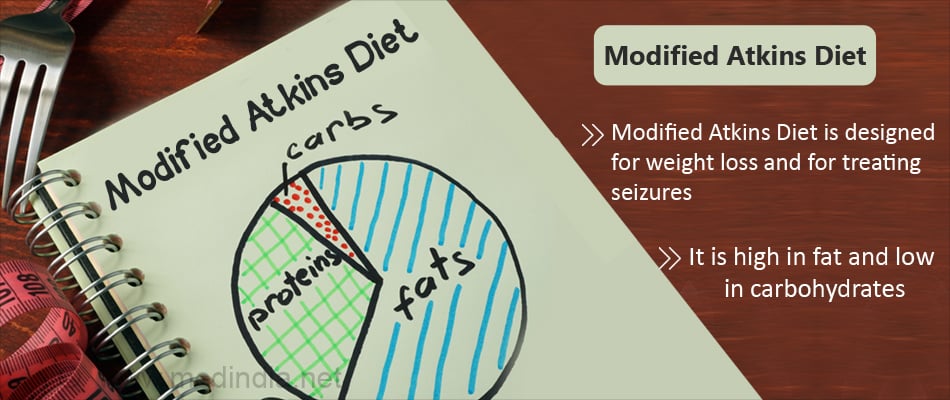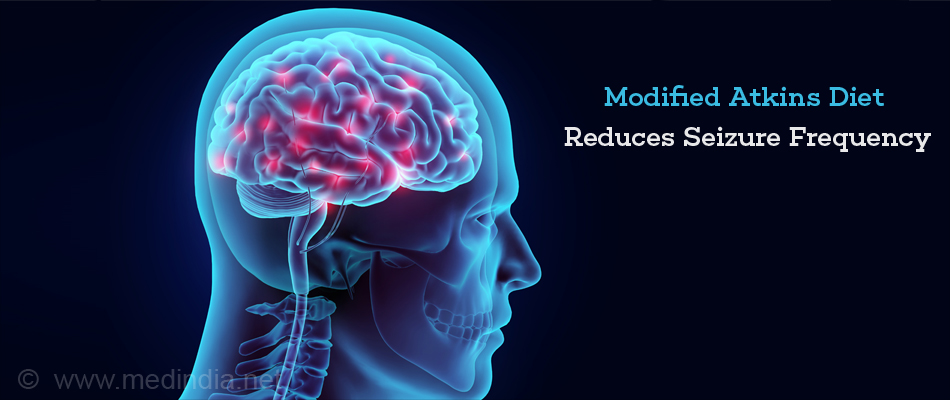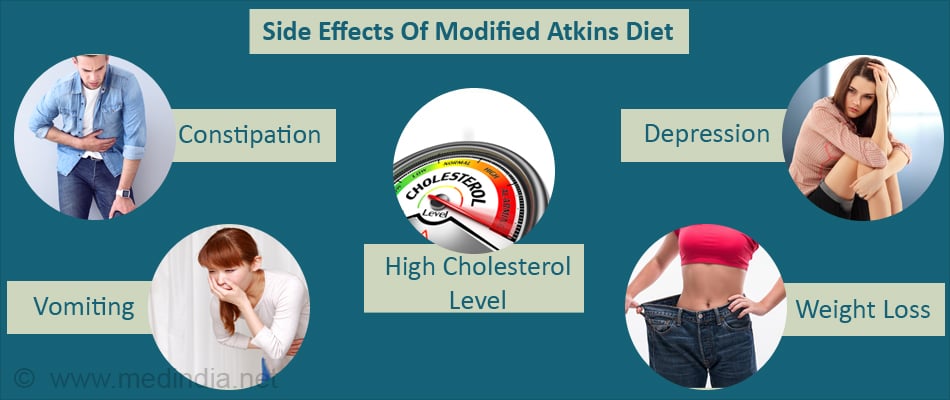Modified Atkins Diet Burn Fat

Article Reviewed by DietitianJulia Samuel, M.Phil
Last Updated on May 20, 2017
What is the Modified Atkins Diet?
The Atkins diet was designed by Robert C Atkins in the United States in the year 1970. The purpose or aim of this diet was weight loss. This diet involves restriction of carbohydrates and liberal intake of fat. Atkins diet allows intake of meals consisting 10% carbohydrates, 60% fat and 30% protein intake.
The 'Modified Atkins diet' has been modified or is different from Atkins diet as it encourages fat intake and limitation of carbohydrate is maintained indefinitely. It is a change to classic ketogenic diet and it is more palatable and less restrictive. Furthermore, it mimics ketosis, that is breakdown of body fat for the purpose of energy.
The goal of modified Atkins diet is seizure control. Initially carbohydrate intake in children is 10 grams per day and 15 grams per day in adults (induction phase). This is then increased to 20-30 grams per day depending on seizure control. Carbohydrates can be given at one meal or it can be divided all throughout the day.
Furthermore, it also allows foods rich in protein such as eggs, chicken, fatty fish and meat such as beef, pork and bacon. Foods with high fat content are encouraged such as full fat dairy products, butter, cream, cheese, mayonnaise, nuts and oil seeds, avocados, coconut oil and olive oil.

- Modified Atkins Diet is designed for weight loss and for treating seizures
- It is high in fat and low in carbohydrates
Difference Between Ketogenic Diet And Modified Atkins Diet
- Modified Atkins diet is less restrictive as compared to ketogenic diet. It offers more food options comparatively
- Modified Atkins diet allows intake of protein rich foods whereas ketogenic diet does not allow it. Thus, it may not affect the growth of children negatively
- The ketogenic diet has a ratio of 4:1 (fat: carbohydrate + protein) and modified Atkins diet has a ratio of 1:1
- Ketogenic diet restricts intake of fluids and calories whereas modified Atkins diet has no such restrictions
- Fats are strongly encouraged in modified Atkins diet but they are not measured or weighed (in ketogenic diet it is measured)
- Before initiating modified Atkins diet patient does not need to fast and the diet can start without being admitted to the hospital (inpatient)
- Modified Atkins diet is easier to implement and follow as compared to ketogenic diet. Thus, it has better compliance and more effective results
Benefits Of Modified Atkins Diet
Anti-Epileptic Effect
Research has found that modified Atkins diet is more effective in reducing seizures in patients with epilepsy as compared to ketogenic diet. Studies have found that following this diet reduces the frequency of seizures by 50% in 6 months.
Ketones are produced in the body due to fat breakdown. These ketones affect the brain chemistry and correct the abnormal electrical activity of brain. Such a diet is useful for individuals with idiopathic generalized epilepsy or for those where anti-epileptic medications do not work.

Treats A Headache
Modified Atkins diet helps in the treatment of chronic daily headache or migraines. When a low carbohydrate, high fat diet is consumed, ketone bodies are produced as a source of fuel in the body.
Ketone bodies are less inflammatory and less demanding as compared to glucose which is otherwise used as a source of energy when a normal diet is consumed. Such a drop in the level of inflammation helps in reducing the frequency and severity of headaches.
Furthermore, modified Atkins diet helps the body to work efficiently because it reduces the oxidative stress. Therefore, a decrease in the levels of inflammation and oxidative stress reduces migraine attack.
Lowers High Blood Glucose Levels
Studies have revealed that following a low carbohydrate, high fat diet (modified Atkins diet) helps to control diabetes. Such a diet improves overall glucose tolerance and helps in the management of hyperglycemia.
Modified Atkins diet helps in weight loss, which in turn helps in lowering blood glucose levels. Furthermore, cutting down carbohydrate intake improves the overall condition and delays the onset of diabetic complications.
Improves Lipid Profile
Modified Atkins diet helps in lowering high levels of LDL and total cholesterol if this diet is followed for 12 months or longer.
A study found that initially the lipid levels would increase during the first 3 months, but then they return to normal range. A drop in total cholesterol, LDL (bad) cholesterol and triglycerides was observed whereas the level of HDL (good) cholesterol increased. Such an improvement in the lipid profile can be attributed to the low carbohydrate intake.
Protects Against Alzheimer's Disease
Research has found that a high fat, low carbohydrate diet such as a modified Atkins diet is beneficial for individuals with Alzheimer's disease.
Treatment with modified Atkins diet lowers the level of 'amyloid beta' which is a brain protein. Such a drop in the level of brain protein improves the overall condition. This further boosts better ability to think and remember and improves concentration level in individuals with Alzheimer's disease.

Anti-Cancer Potential
Modified Atkins diet is beneficial for cancer patients with tumors. It suppresses the growth of tumor and reduces its size.
Additionally, it lowers oxidative stress and overall inflammation, which are the main causative factors for cancer. Furthermore, it also improves the overall quality of life of cancer patients. Thus, modified Atkins diet may be healthy for individuals with lung cancer, skin cancer and brain cancer.
Side Effects Of Modified Atkins Diet
Research has found that modified Atkins diet is well tolerated. Few studies have found certain side effects of this diet, but they are fewer compared to ketogenic diet. Some of them include:
- Constipation is the most common side effect of this diet. Its low carbohydrate content and lack of dietary fiber may lead to constipation.
- Vomiting is common because high fat diet leads to the production of ketones which further make individuals feel ill and uncomfortable. One may not want to eat anything or may vomit after eating.
- There is a slight chance of developing kidney stones.
- Depression and mood swings are common.
- High cholesterol level (total and LDL) is common during the first 3 months of diet.
- Weight loss and diminished growth in children can affect their overall health.

- Constipation
- Vomiting
- Depression
- High cholesterol level
- Weight loss
Note
- Individuals with seizures or their parents should be taught on carbohydrate counting, reading the food labels and identification of high fat foods.
- The carbohydrate intake can be increased gradually, but the overall carbohydrate intake will always be low.
References:
- The Modified Atkins Diet in Refractory Epilepsy - (https://www.ncbi.nlm.nih.gov/pmc/articles/PMC3929267/)
- Efficacy of the Atkins diet as therapy for intractable epilepsy - (https://www.ncbi.nlm.nih.gov/pubmed/14694049)
- A modified Atkins diet is effective for the treatment of intractable pediatric epilepsy - (https://www.ncbi.nlm.nih.gov/pubmed/16499770)
- Use of a modified Atkins diet in intractable childhood epilepsy - (https://www.ncbi.nlm.nih.gov/pubmed/17241226)
- Efficacy and tolerability of the modified Atkins diet in young children with refractory epilepsy: Indian experience - (https://www.ncbi.nlm.nih.gov/pmc/articles/PMC5144480/)
Published on May 20, 2017
Latest Publications and Research on Modified Atkins Diet: All You Need to Know
Source: https://www.medindia.net/dietandnutrition/modified-atkins-diet-all-you-need-to-know.htm







Tidak ada komentar:
Posting Komentar